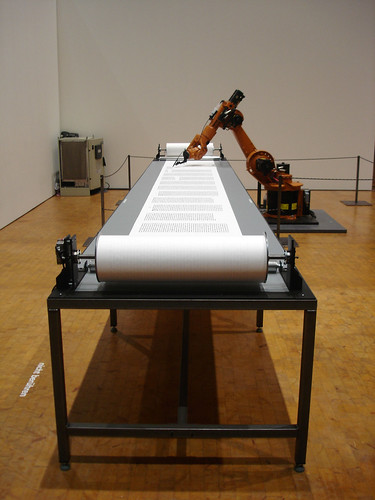 A German group, Robotlab, has constructed this robotic arm that does calligraphy. (Thanks to Michael Lieberman for this tip.) In this display, it is "hand" writing the Luther Bible. Note the use of THE iconic German Bible for purposes of this demonstration.
A German group, Robotlab, has constructed this robotic arm that does calligraphy. (Thanks to Michael Lieberman for this tip.) In this display, it is "hand" writing the Luther Bible. Note the use of THE iconic German Bible for purposes of this demonstration.One commenter notes the irony in choosing this text to render mechanically in imitation calligraphy when it was originally printed. Another irony is the choice of the scroll form for the convenience of the machine, instead of the codex sheets more easily handled by printing presses.
 Advocates of the possibilities inherent in new electronic media (such as the folks at if:book) often decry the wide-spread tendency to use new technology anachronistically, rather than taking advantages of its possibilities. They would probably not be comforted by the observation that this tendency is very old. This robot reproduces calligraphy because, despite five-and-a-half centuries of printing, careful hand calligraphy retains connotations of prestige and expense. Thus famous documents, like the U.S. Declaration of Independence and Constitution, are displayed and reproduced in calligraphic form, which is how they are popularly remembered, despite the fact that the originals were printed broadsheets. It was the secondary, anachronistic hand-written form that was given iconic status.
Advocates of the possibilities inherent in new electronic media (such as the folks at if:book) often decry the wide-spread tendency to use new technology anachronistically, rather than taking advantages of its possibilities. They would probably not be comforted by the observation that this tendency is very old. This robot reproduces calligraphy because, despite five-and-a-half centuries of printing, careful hand calligraphy retains connotations of prestige and expense. Thus famous documents, like the U.S. Declaration of Independence and Constitution, are displayed and reproduced in calligraphic form, which is how they are popularly remembered, despite the fact that the originals were printed broadsheets. It was the secondary, anachronistic hand-written form that was given iconic status.






No comments:
Post a Comment